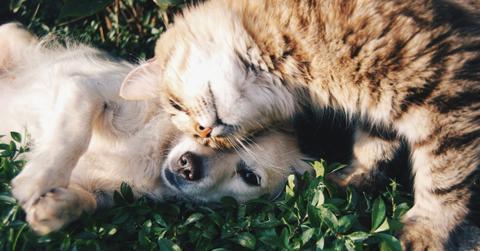Study Reveals the Trick to Successfully Introducing Cats and Dogs
This hack may make growing your furry family a whole lot easier.
Published Oct. 14 2024, 12:29 p.m. ET

There's a reason why the saying "fighting like cats and dogs" is a popular one. That's because cats and dogs notoriously do not get along with one another, forcing many people to choose between being a cat household or a dog one.
But, there's good news for those brave folks who want to bring double the love into their homes by adopting both a cat and a dog. A 2024 study seems to have unlocked the secret to ensuring a peaceful first introduction.
And the best part about this hack? When done correctly it won't just ensuring that the fur doesn't start flying the second the pair meet, it may even help your cat and dog to develop a lifelong bond with one another.
Keep reading to learn more about the trick to introducing cats and dogs.

Introducing cats and dogs slowly is the trick to making a good first impression, according to research.
We often hear so much about the importance of a good first impression when we're meeting our new partner's parents or interviewing for a job. But the first meeting between cats and dogs also needs to start out on the right paw... er, I mean foot... in order to assure a successful relationship.
At least, that's what a 2024 report from the Dogs Trust website claims.
The findings are being presented during the New Scientist Live 2024 convention at ExCeL London during the weekend of Oct. 19, 2024, according to The Independent. Reporters for the publication got a sneak peek at the findings, and they claim that the report has uncovered that gradual introductions go a lot better for both the cat and the dog, allowing the new friends to slowly warm up to one another instead of being thrust together before they're fully comfortable.
And that's not all. The report says that there are a few other factors — like the age and demeanor of the dog — that can also make a huge difference.
How to introduce cats and dogs:
Now that you know that slow and steady is best, here are some other tips that the report will cover once it's released. First, ensure that your cat has a clear escape route when introducing them to a new dog.
That doesn't necessarily mean an open door, according to Dr. Rachel Casey, a vet and researcher who spoke with The Independent about the report. Instead, it could be something as simple as an elevated surface where the kitty can flee to when she's had enough.
Next, Dr. Casey says that it's important to ensure that the puppy isn't too aggressive during that first meeting.
“What you really need to teach the puppy is to be calm in the presence of the cat," she told the publication. “So you want to have them introduced at a time and a place where everybody is sitting down, it’s really quiet, and probably have the puppy on a lead and distract it with something, so you’re doing that introduction gradually."
One other thing Casey says will help you as you're introducing the new members of your blended furry family: age. She says that puppies under the age of 12 weeks are the group most likely to exhibit the kind of behavior conducive to a successful first meeting.
That being said, it sounds like pet parents are likely to have better luck at any age when they follow the directions offered by Dog Trust and keep introductions calm and brief during those first few days of co-habitation.